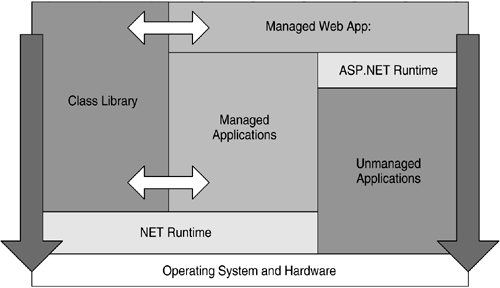Highlights of .NET
| If other major development releases from Microsoft could be heard as "bangs," the arrival of .NET could be heard with an atomic explosion. The last major development release was Visual Studio, when the cry for a shared integrated environment (IDE) was partially answered by Microsoft. I say partially because Visual Basic still used its own IDE in 6.0. Not only does Visual Studio .NET finally serve as the primary IDE for all .NET languages, but the .NET framework itself has complete cross-language support built into its runtime. Using cross-language inheritance, exception handling, and debugging, developers can truly choose their weapon of choice. This was a calling card of component models for years but not at the level of simplicity and single implementation support that Visual Studio .NET and the framework provide. References to the word new when referring to .NET may receive a few scoffs, especially from those in the Java world. But the word new isn't necessarily referring to the field of computer science but to the Microsoft development community. Object-oriented languages have been around for a few decades. Managed (ergo garbage-collected ) environments also have quite a track record by now. So why is .NET so different? First of all, it really isn't much different than many of the technologies already available. The problem is that those technologies are spread across several languages, vendors , and accepted platforms. The .NET framework is not any copy of one particular implementation or technology but a culmination of benefits extracted from several environments. Not only is this delivered in one framework, but it also comes to us in a form that is usable and quick to employ . To get a feel for the major components that make up the .NET framework refer to Figure 1.10 and Table 1.2. Java programmers already familiar with a Virtual Machine environment should recognize these layers . Figure 1.10. An overview of .NET and how it is layered into the operating system. The speed at which one will adapt and understand .NET heavily depends on that person's background. Suffice it to say, however, that once the newness hurdle is overcome , the learning rate will increase faster than any other development platform Microsoft has offered thus far ”even Visual Basic. Yes, even Visual Basic. With the aid of Visual Studio .NET and Intellisense, you will soon see how quickly the learning slope slides south (say that three times fast). Hopefully before you read this book you will have jumped the initial learning hurdle of .NET. Either way, you should have a firm grasp of the following .NET building blocks. If not, then I recommend reading read one of the myriad of .NET framework books out there. |
EAN: 2147483647
Pages: 70
